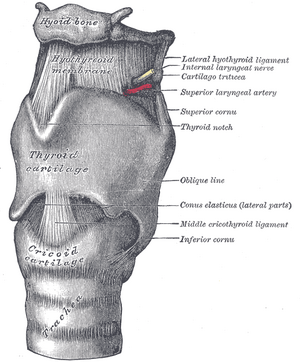- For other uses, see Adam's apple (disambiguation).

An example of male laryngeal prominence.
The human larynx rests in a frame of cartilage bound by ligaments and muscles. At the front is the thyroid cartilage, creating the lump at the front of the neck, known as the laryngeal prominence or more commonly as the Adam's apple.
Regarding the etymology of the term "Adam's apple", Webster's 1913 dictionary states that the term "… is so called from a notion that it was caused by the forbidden fruit, (an apple) sticking in the throat of our first parent."
Laryngeal prominence[]
There is a misconception that larynx growth during puberty results in the Adam's Apple being typically more prominent in men than in women or prepubescent girls or boys. While this growth of the larynx is responsible for the voice cracking in teenage boys, it really has nothing to do with the actual prominence of what is clinically viewed as the Adam's Apple itself. The main reason for the Adam's apple usually being more prominent in males is that the two laminae of the thyroid cartilage that form the protrusion meet at an angle of 90° in males but that angle is 120° in females. Still, there are a number of exceptions where the cartilage on a woman's throat is formed at that same 90°.
Although a prominent Adam's Apple is commonly considered a secondary sex characteristic, it is not influenced by hormones. In other words, a person that doesn't have a prominent Adam's Apple cannot cause their body to have one. It is simply a genetic draw of the cards. That is why women with noticeable Adam's Apples are by no means extremely rare. Notable examples of well-known women with prominent Adam's Apples include American actresses Sandra Bullock, Meg Ryan, Kelly Rowan, though the best representative of high profile females with rather large Adam's Apples would be Italian Actress Francesca Neri.
For some transwomen and a few men, the Adam's Apple is more prominent than desired, and this is sometimes remedied by a chondrolaryngoplasty (trachea shave), a type of plastic surgery to reduce the size of the Adam's Apple. This surgery is not without risk as it can adversely effect the voice and cause permanent damage.
Thyroid cartilage[]

The cartilages of the larynx.
The thyroid cartilage is the largest of the nine cartilages that make up the laryngeal skeleton, the cartilage structure in and around the trachea that contains the larynx. It is composed of two plate-like laminae that come together on the anterior side of the cartilage to form a peak, called the laryngeal prominence. This prominence is often referred to as the "Adam's Apple". The laryngeal prominence is obvious in both sexes, but it tends to be somewhat more robust in the adult male. The lip of the thyroid cartilage just superior to the laryngeal prominence is called the thyroid notch or superior thyroid notch.
The two laminae that make up the main lateral surfaces of the thyroid cartilage extend obliquely to cover either side of the trachea. The posterior edge of each lamina articulates with the cricoid cartilage inferiorly at a joint called the cricothyroid joint. Movement of the cartilage at this joint produces a change in tension at the vocal folds, which in turn produces variation in voice. The entire superior edge of the thyroid cartilage is attached to the hyoid bone by the thyroid membrane.
The thyroid cartilage forms the bulk of the anterior wall of the larynx, and serves to protect the vocal folds ("vocal cords") which are located directly behind it. It also serves as an attachment for several laryngeal muscles.
Etymology[]
There are two main theories as to the origin of the term "Adam's apple". The "Brewer's Dictionary of Phrase and Fable" and the 1913 edition of Webster's Dictionary point at an ancient belief that a piece of forbidden fruit was embedded in the throat of Adam, who according to the Abrahamic religions was the first man. However, neither the Bible nor other Judeo-Christian or Islamic writings mention such a story. In fact, the biblical story does not even specify the type of fruit that Adam ate, though in the Western Christian tradition, the fruit is commonly portrayed as an apple.
Linguist Alexander Gode claimed that the Latin phrase to designate the laryngeal prominence was very probably translated incorrectly from the beginning. The phrase in Latin was "pomum Adami" (literally: 'Adam's apple'). This, in turn, came from the Hebrew "tappuach ha adam" meaning "apple of man". The confusion lies in the fact that in Hebrew language the proper name "Adam" (אדם) literally means "man", and the word for "apple" is similar to the word "tafuach" which means "swollen", thus in combination: the swelling of a man. Proponents of this version contend that the subsequent phrases in Latin and other Romance languages represent a mistranslation from the start.
The medical term "prominentia laryngea" (laryngeal prominence) was introduced by the Basle Nomina Anatomica in 1895.
In the American South, goozle is used colloquially to describe the Adam's apple, likely derived from guzzle.
|
HEAD: Forehead – Eye – Ear – Nose – Mouth – Tongue – Teeth – Jaw – Face – Cheek – Chin TORSO: Shoulders – Spine – Chest – Breast – Ribcage – Abdomen – Belly button LIMBS: Arm – Elbow – Forearm – Wrist – Hand – Finger (Thumb - Index finger - Middle finger - Ring finger - Little finger) – Leg – Lap – Thigh – Knee – Calf – Heel – Ankle – Foot – Toe (Hallux) | |
de:Adamsapfel et:Kõrisõlm eo:Tireoido fr:Pomme d'Adam id:Jakun nl:Adamsappel sv:Adamsäpple wa:Gaviote
| This page uses Creative Commons Licensed content from Wikipedia (view authors). |
